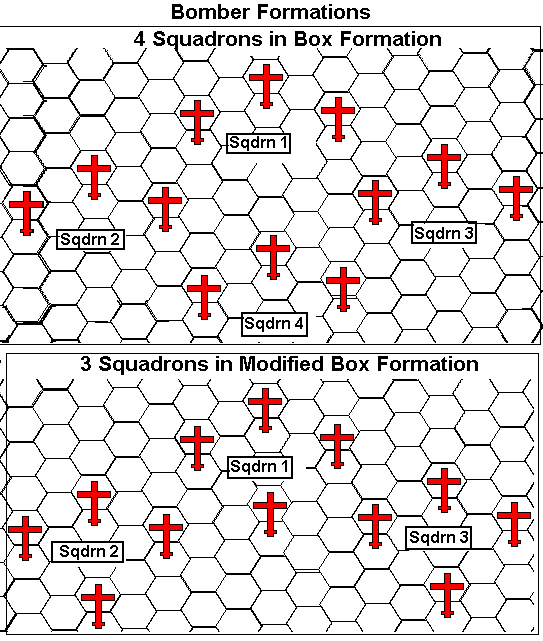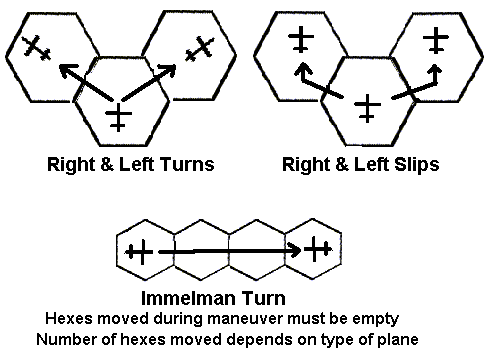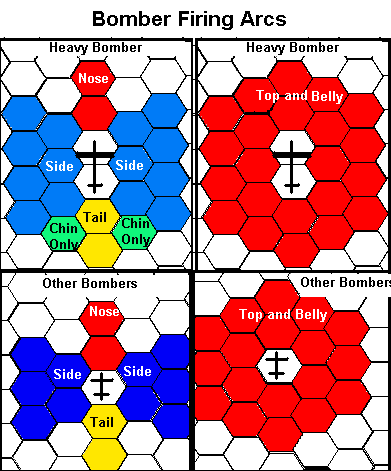
Playtest: These rules have been tested numerous times with large groups of players. They work well and produce a fast and fun game.
The Models: Plastic model planes are readily available in 1/144 scale. The 1/144 models are cheap, and just the right size. They are also very easy for the students to build. You can find die-cast planes from manufacturers like Sky Wings, In Air, Corgi and Model Power. Look for planes sold in sets at toy stores for the best deals. The scale of the die-cast planes is inconsistent, so be careful when buying them if this is a concern. Here are some simple paper airplane models you and print and use. Additional free paper airplanes are available from a lot of web sites, just look around. Paperworlds.com and FreePaperToys.com is a good place to start a search. You can also purchase origami airplane models for at Fiddler's Green and Papertigerarmaments.com.
The Board: The battle will be played on a hex mat. A 5' square is about the minimum for dogfights with fighters. A longer board will be needed for bombing runs. If you're doing a bombing run several hexes near the end of the board should be marked as the targets of the bombers. The hexes should be about 4" in size and the pattern can be drawn by tracing a cardboad hexagon. The hex pattern should be aligned so the two sides have a straight path of hexes to each other and any bombing targets.
Deployment: Opposing sides should be deployed at least 4 hexes away. If you are doing a bombing run the bombers should start at one end of the table with their targets at the far end. The bombers should be in formation of three or four bombers and should try to stay in formation as they fly to maximize their protection. Note that heavy bombers will occupy two hexes. Fighters should start out grouped into squadrons. Planes should always be placed in hexes so that they face a hex side, not a corner.

Scenarios: It's easy to make up your own scenarios, but here are a few to help you get started
Zekes in the Slot: Japanese Zeroes against American Corsairs or P-38s. There should be about 2 Zeroes for every American plane.
Yamamoto's Defeat: American fighters try to intercept and kill Admiral Yamamoto. 6 P-38s against 2 Betty bombers and 8 Zeroes. The Japanese player must secretly record which bomber is carrying Yamamoto. The Americans must shoot down Yamamoto's plane to win the scenario.
Bombers over Berlin: American or British bombers with escorts must fight through German interceptors to reach their targets. Use a long table with three bombing targets at the far end. Use a force ratio of 1 bomber squadron (4 planes each) and one escorting fighter squadron (6 planes each) for every 4 squadrons (6 planes each) of German interceptors. The Allies must destroy one of the bombing targets to win the scenario.
Deck of Cards: Use a standard deck of playing cards. Take out one card for each fighter plane and bomber squadron and shuffle them together. The planes should be clearly marked so the players will be able to remember which plane moves on which card.
Rules
Sequence of Play:
1. Draw Card
2. Active Planes Move
2. Active Planes Shoot
3. Bombing
Choose Cards: Turn over the top card in the deck. The fighter plane or bomber squadron that is assigned to that card will now move and shoot. Note that all bombers in a squadron move and shoot at the same time. This helps them to stay in formation. After each plane has completed its move and shoot draw the next card. Continue until every plane has had a chance to move then shuffle the deck and repeat the process. Remove the cards of planes that are shot down.
Active Planes Move: Each plane has a Speed rating that indicates the maximum number of hexes the plane can move. Planes must ALWAYS move at least one hex. It costs one hex of movement to move forward or slip to the right or left. When a plane slips it doesn't change facing, it slides over and forward (see diagram). Planes also have a Turn rating which indicates the cost in hexes for a turn. A turn is performed by changing the plane's facing one hexside to the left or right and then moving forward (see diagram). Each plane also has an Immelman rating that indicates the cost in hexes for the plane to execute an Immelman turn (also known as a split S). When performing an Immelman turn the plane moves forward a number of hexes equal to it's Immelman rating then in the last hex it changes facing by 180-degrees. The hexes the plane moves through while performing the Immelman turn can NOT contain any other planes. Each plane can move and maneuver as it wishes as long as the total cost doesn't exceed its speed. Moving planes can fly through hexes that contain other planes but they may not end their move in a hex that contains another plane.

Resolve Shooting: Fighter planes may ONLY fire at enemy planes that are in the line of hexes directly in front of their nose, they may not fire off to the sides or at an angle. Fighters can shoot 4 hexes. Fighter planes with a tail gun can only fire the tail gun at enemy planes in the line of hexes directly behind them and are limited to a range of 2 hexes. Planes block line of sight, so you can't shoot through friendly planes. The Gun rating indicates the number of dice to roll when shooting. The Shooting table shows the die roll needed to score a hit. Hits must be recorded on the target plane. This can be done by putting small markers on the base or wings or you can keep a written record. When the number of hits on a plane equals its Damage rating it is shot down and removed from play. Damage to a plane does not affect the plane's ability to move or shoot (heavy bombers are an exception).
| Range (Hexes) | 1 | 2 | 3 | 4 | Gun rating is number of dice to roll. Bombers and tail guns shoot only 2 hexes. |
| Dice Roll to Hit | 3 - 6 | 4 - 6 | 5 - 6 | 6 |
Bomber Firing Arcs: Bombers have different firing arcs and their guns are limited to a range of 2 hexes. The diagram shows where each bomber turret can fire.

Engine Hits: When a fighter scores a hit on a heavy bomber with a roll of 6 there is a chance that an engine was hit. Roll again for each 6 that was rolled to hit the heavy bomber. If the second roll is a 4 - 6 then an engine was destroyed. Engine hits can be marked by putting cotton on the plane. Each engine hit after the first one reduces the speed of the bomber by 1 hex. If a bomber is reduced to speed 0 then it rolls 1 die each turn and it can move 1 hex on a roll of 4 - 6. If a bomber loses all of its engines it is shot down.
Bombing: If a bomber has moved onto a hex containing a target it gets a chance to destroy the target with bombs. The bomber rolls 1 die. If the roll is equal to the hit numbers in the plane's Bomb rating then the target is destroyed.
| Allies |
|
(Front/Tail) |
|
|
|
|
| P-38 Lightning | 1 | 4 | 6 | 4 | 5 | 8 |
| P-40 Warhawk | 1 | 3 | 4 | 3 | 4 | 5 |
| P-47B Thunderbolt | 1 | 4 | 6 | 3 | 4 | 8 |
| P-51 Mustang | 1 | 3 | 5 | 3 | 2 | 7 |
| P-61A Black Widow | 3 | 6 | 5 | 4 | - | 10 |
| F4U Corsair | 1 | 3 | 5 | 2 | 3 | 6 |
| F4F Wildcat | 1 | 3 | 3 | 2 | 3 | 6 |
| F6F Hellcat | 1 | 3 | 5 | 3 | 4 | 7 |
| Hurrican IID | 1 | 4 | 4 | 3 | 3 | 6 |
| Spitfire I - V | 1 | 4 | 4 | 2 | 2 | 5 |
| Spitfire IX - XIV | 1 | 4 | 5 | 2 | 3 | 5 |
| Mosquito FB Mk IV | 2 | 6 | 5 | 4 |
|
|
| Mig-3 | 1 | 3 | 5 | 2 | 3 | 5 |
| La-5/7 | 1 | 3 | 5 | 2 | 3 | 5 |
| Yak-7/9 | 1 | 3 | 5 | 2 |
|
|
| Airacobra | 1 | 4 | 5 | 3 |
|
|
| Axis | ||||||
| Me109E | 1 | 3 | 5 | 2 | 2 | 5 |
| Me 109G | 1 | 4 | 5 | 3 | 3 | 6 |
| Me 110G | 1+1 | 4/1 | 4 | 4 | 4 | 8 |
| FW 190A | 1 | 4 | 5 | 3 | 3 | 7 |
| Me 262 | 1 | 5 | 9 | 5 | 6 | 6 |
| A6M5 Zero Army | 1 | 3 | 4 | 2 | 3 | 5 |
| A6M5 Zero Navy | 1 | 2 | 3 | 1 | 2 | 4 |
| Ki-43 Oscar | 1 | 1 | 4 | 2 | 2 | 5 |
| Ki-45 Nick | 1+1 | 4/1 | 4 | 4 | 4 | 8 |
| Allies |
|
|
|
|
|
|
|
||||
|
|
|
|
|
|
|||||||
| B-17G Fortress | 10 | Heavy | 2 | 2 | 2 | 1 | 2 | 2 | 2 | 22 | 3-6 |
| B-24J Liberator | 8 | Heavy | 2 | 2 | 2 | 1 | 2 | 3 | 3 | 18 | 3-6 |
| B-25D Mitchell | 5 | Heavy | 4 | 3 | - | 1 | 2 | 3 | 3 | 10 | 4-6 |
| TBF Avenger | 3 | Light | 2 | 1 | - | - | 4 | 3 | 3 | 5 | 3-6 |
| Lancaster | 6 | Heavy | 2 | 2 | - | - | 4* | 3 | 3 | 18 | 3-6 |
| IL-2 | 2 | Fighter Bomber | 4 | - | - | - | 1 | 3 | 3 | 5 | 5-6 |
| Tu-2 | 4 | Medium | - | - | 2 | - | 2 | 4 | 4 | 13 | 4-6 |
| Pe-2 | 3 | Light | 1 | 1 | - | - | 1 | 4 | 4 | 7 | 5-6 |
| Axis | |||||||||||
| JU-87D |
|
|
|
|
|
|
|
|
|
|
|
| JU-88G | 4 | Medium | 2 | 2 | - | - | 2 | 3 | 3 | 14 | 4-6 |
| HE-111H | 5 | Medium | 2 | 2 | - | 1 | 2 | 3 | 3 | 12 | 4-6 |
| B5N Kate | 3 | Light | - | - | - | - | 1 | 3 | 3 | 4 | 5-6 |
| D4Y Judy | 2 | Light | - | - | - | - | 1 | 4 | 4 | 3 | 5-6 |
| G4M2 Betty | 7 | Medium | 2 | 1 | - | 2 | 2 | 3 | 2 | 9 | 4-6 |
Additional Planes: You can use this conversion table to generate game statistics for other planes. Use common sense and adjust any ratings that seem out of line.
| Guns |
1 Machine Gun = 1/2 die |
Speed (MPH) |
|
|
|
Fighters: Weight / 100 up to 7000 lbs, Weight / 200 after that Bombers: Weight / 200 |
|
Miles Per Hour / 100 (round up) |
|
|
Add MPH / 50 | ||
| Turn | 2 x Weight in 1000s / Speed (adjust according to speed) |
|
Add MPH / 25 |
Resources: Here are some useful resources for WW II aerial combat